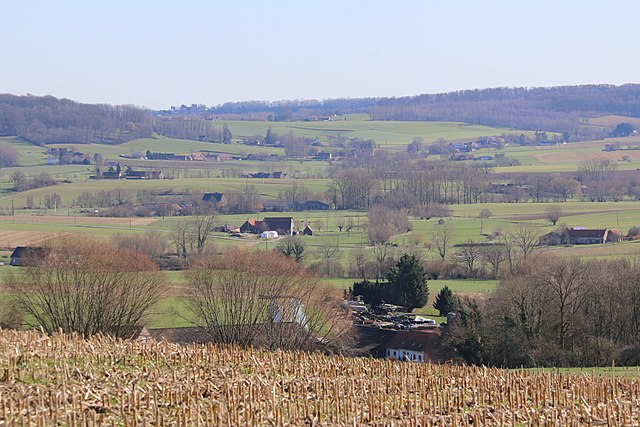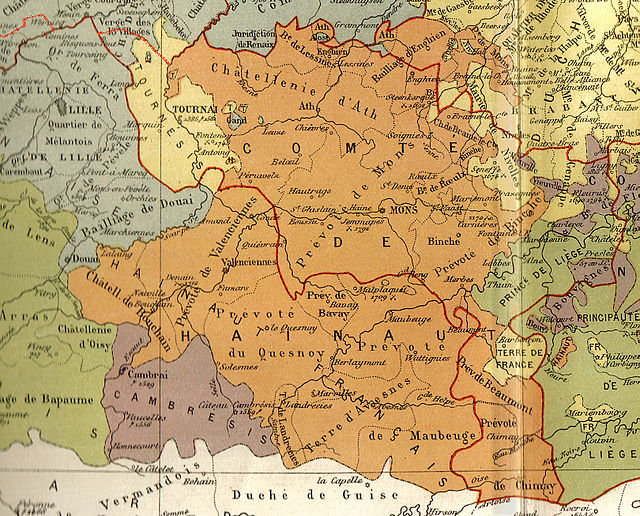Hainaut Province
Province of Belgium From Wikipedia, the free encyclopedia
Province of Belgium From Wikipedia, the free encyclopedia
Hainaut (/eɪˈnoʊ/ ay-NOH, also US: /heɪˈ-, ɛˈ-/ hay-, eh-, UK: /ˈ(h)eɪnoʊ/ (H)AY-noh;[5][6][7] French: [ɛno]; Dutch: Henegouwen [ˈɦeːnəɣʌu.ə(n)] ; Walloon: Hinnot; Picard: Hénau), historically also known as Heynault in English, is the westernmost province of Wallonia, the French-speaking region of Belgium.
Hainaut
Heynowes | |
|---|---|
|
| |
 | |
| Coordinates: 50°30′N 3°55′E | |
| Country | |
| Region | |
| Capital | Mons |
| Largest city | Charleroi |
| Government | |
| • Governor | Tommy Leclercq |
| Area | |
| • Total | 3,813 km2 (1,472 sq mi) |
| Population (1 January 2024)[2] | |
| • Total | 1,360,074 |
| • Density | 360/km2 (920/sq mi) |
| GDP | |
| • Total | €36.940 billion (2021) |
| ISO 3166 code | BE-WHT |
| HDI (2021) | 0.893[4] very high · 11th of 11 |
| Website | portail |

To its south lies the French department of Nord, while within Belgium it borders (clockwise from the north) on the Flemish provinces of West Flanders, East Flanders, Flemish Brabant and the Walloon provinces of Walloon Brabant and Namur.
Its capital is Mons (Dutch: Bergen) and the most populous city is Charleroi, the province's urban, economic and cultural hub, the financial capital of Hainaut and the fifth largest city in the country by population. Hainaut has an area of 3,831 km2 (1,479 sq mi) and as of January 2024 a population of over 1.36 million.[8] Another notable city is Tournai (Dutch Doornik) on the Scheldt river, one of the oldest cities in Belgium and the first capital of the Frankish Empire.
Hainaut province has a rolling landscape, except for the very southern part, the so-called Boot of Hainaut, which is quite hilly and belongs to the Ardennes and its foothills Fagne and the Condroz.
The village of L'Escaillère in the utmost southeastern corner, at an altitude of 365 metres, is the highest point of the province.
In the Boot of Hainaut on the border of Namur province the artificial five Eau d'Heure lakes are situated, the largest lake area of Belgium.
A well-known region is the Borinage, the old coal mining region around the city of Mons. Also well-known is the Pays des Collines (English: "Hill Country"), a low hilly area forming one natural region with the Flemish Ardennes in the East Flanders province.
In addition to the main language French, Picard is spoken in the western and central parts of the province, while in the eastern part a mixture of Walloon and Picard is spoken (Wallo-Picard).
Some Flemish and Brabantic dialects of Dutch are spoken in the municipalities bordering the Flemish region.

The province derives from the French Revolutionary Jemmape department, formed in 1795 from part of the medieval County of Hainaut, the small territory of Tournai and the Tournaisis, a part of the county of Namur (Charleroi), and also a small part of the Prince-Bishopric of Liège (Thuin). (A large part of the historical county of Hainaut is now within France and sometimes referred to as French Hainaut.)
Hainaut province is divided into 7 administrative districts (arrondissements), subdivided into a total of 69 municipalities. It has an area of 3,831 square kilometres (1,479 sq mi).

The gross domestic product (GDP) of the province was €34.2 billion in 2018, accounting for 7.4% of Belgium's economic output. GDP per capita adjusted for purchasing power was €22,500 or 75% of the EU27 average in the same year. Hainaut is the province with the second lowest GDP per capita.[9]
The patron saint of the province Hainaut is Saint Waltrude.[10]
Seamless Wikipedia browsing. On steroids.
Every time you click a link to Wikipedia, Wiktionary or Wikiquote in your browser's search results, it will show the modern Wikiwand interface.
Wikiwand extension is a five stars, simple, with minimum permission required to keep your browsing private, safe and transparent.